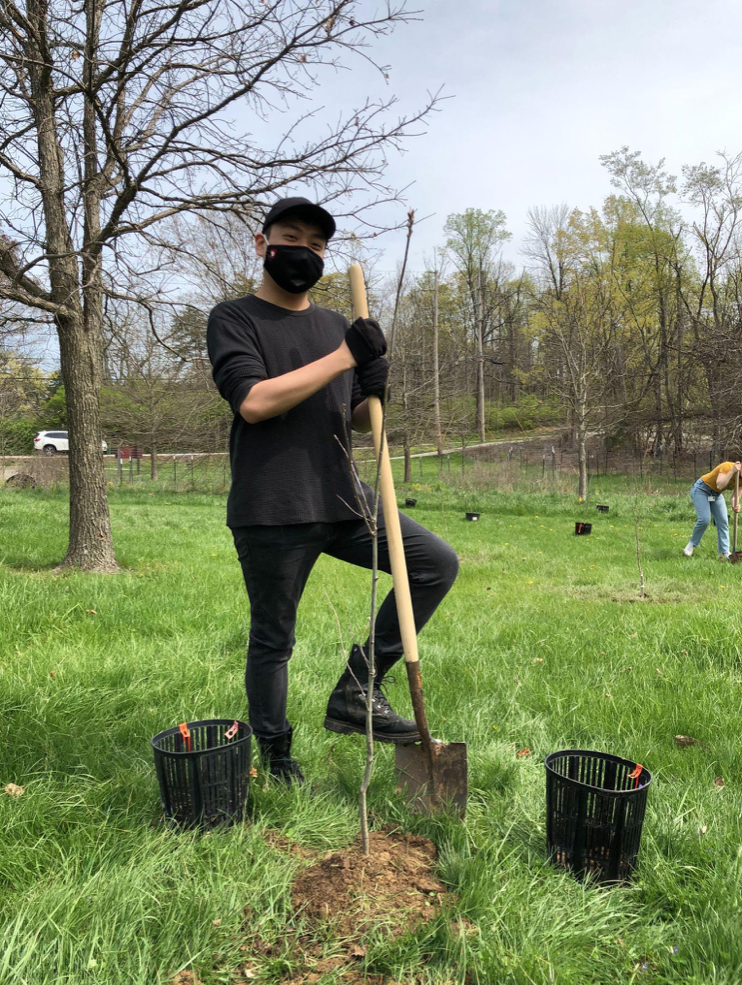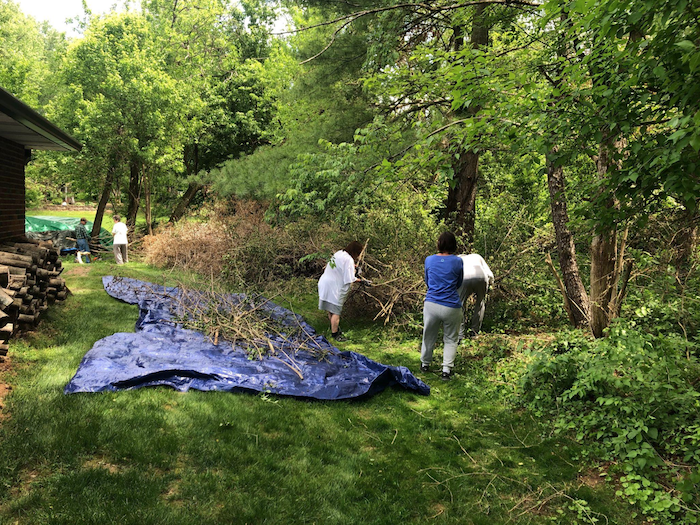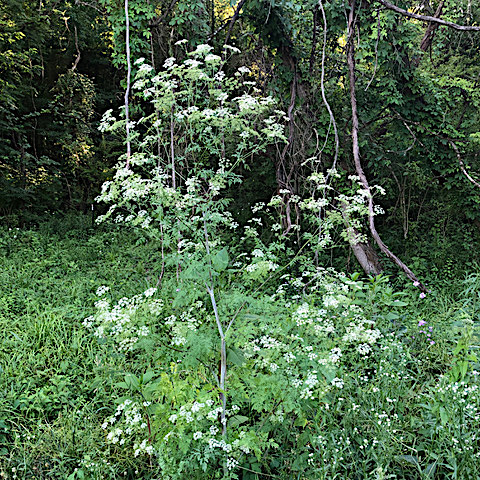This April, a few friends and I went on a road trip to Kentucky. Having spent two days in Louisville sampling bourbon and touring the Muhammad Ali Center, we drove to the Mammoth Cave National Park in central Kentucky. After learning the rich history of the longest known cave system on Earth, we decided to go on a hike before making the drive back to Indiana.
The park ranger assured us that the view of the Green River would be spectacular, as long as we were willing to navigate the hilly terrain to reach the lookout point. The trail began on a hillside overlooking a valley. Immediately, I was struck by the sight of countless pretty white flowers blanketing the valley. Merely three weeks prior, I would have thought nothing more of the scene and merrily continued on my hike. However, becoming a volunteer for Monroe County–Identify and Reduce Invasive Species (MC–IRIS) had given me a new perspective and opened my eyes to the scale and scope of the invasive-plant problem affecting every single community in the U.S.

Garlic mustard blankets the valley in Mammoth Cave National Park in Kentucky. While its petite white flowers might be nice to look at, the invasive plant kills soil fungus that native plants rely on; garlic mustard even poisons caterpillars of the West Virginia white butterfly. | Photo by Sean Chung
The plants I saw at the Mammoth Cave National Park were garlic mustard, also known as Alliaria petiolata. With petite white flowers, garlic mustard looks innocent enough. A second-year garlic mustard can grow up to four feet and a garlicky aroma effuses when the jagged, triangular leaves are crushed. When it is mature enough to reproduce, light green seed pods branch upward from the stem. When the seed pods turn brown, all it takes is a little nudge for the pods to spring out and disseminate seeds that can continue the cycle.
Although garlic mustard can be pleasant to look at, looks can be deceiving. Native to Europe, the plant is hardy and can disrupt local ecosystems. Garlic mustard does this by secreting a harmful substance that kills soil fungus, which native plants depend on to expand their root systems. Through inhibiting the growth of native plants, garlic mustard can grow faster and completely displace them on a landscape. This has implications for native insects too. The West Virginia white butterfly primarily feeds on toothwort, which, like garlic mustard, belongs to the mustard family. However, where toothwort provides a habitat for the butterflies to lay their eggs, garlic mustard is toxic and almost always kills the caterpillar. The rapid spread of garlic mustard across the Midwest further jeopardizes a vulnerable species.
Removing garlic mustard is not difficult. A firm tug will ensure that its roots are completely removed without snapping the brittle stem. For an amateur, learning to identify the plant is far more difficult. Garlic mustard can look very different over its life stages, beginning as a green basal rosette that can grow up to four feet in two years.
Before I joined MC–IRIS, I would have never imagined that invasive plants were so out of control in my community. Without a base of knowledge, it is extremely easy to underestimate the scale and scope of the problem. After all, if you don’t know how to identify a plant, they all sort of look the same. As a Monroe County–based nonprofit organization focused on raising awareness of invasive species and building partnerships with stakeholders within the community, MC–IRIS has been instrumental in introducing me to various invasive plants. Over the months, I learned to identify and uproot plants like Asian bush honeysuckle, multiflora rose, and Japanese stiltgrass.
Uprooting the problem
My education on invasive plants began in Southeast Park. Tucked in the residential neighborhood of Sycamore Knolls, Southeast Park is home to a multitude of invasive plants. A layperson would never know that the park is home to destructive plants like burning bush and lesser celandine, especially when they are so “pretty” to look at. The problem is so severe that the Bloomington Parks and Recreation Department hosts “weed wrangles” to cut down a different species of invasive plant each week.

The author plants a native tree at Southeast Park during a volunteer day with MC–IRIS. | Courtesy photo
Southeast Park is not the only park overrun by invasives. According to Joanna Sparks, the city landscaper for the city of Bloomington, all of the city’s urban parks have been infested by invasive plants. As a general rule, the smaller and narrower the park and the lengthier the “edge” of the park, the worse the problem. The reason for this phenomenon goes back decades, when homeowners planted invasive plants like the purple wintercreeper and privet on their properties. As these invasives matured, their seeds were spread by birds, causing parks adjacent to these properties to be inundated with seed.
Invasive plants begin to cause real damage when they outcompete native plants for space and resources. When that happens, invasive plants can completely take over an area, leaving no room for native plants such as trillium and toothwort. Furthermore, animals, insects, and birds native to Indiana are dependent on native plants. They have evolved to feed on these plants. As Sparks eloquently puts it, “If you don’t have native plants, you don’t have caterpillars, and if you don’t have caterpillars, you don’t have native birds, you don’t have native animals. And you have an ecological collapse.”
Exacerbating the problem is climate change. Scientific research suggests that as temperatures rise and the concentration of carbon dioxide increases, invasive plants may be able to grow even faster and outcompete native plants, accelerating the vicious cycle of ecosystem destruction.
That kind of “ecological collapse” can ultimately affect humans in ways that many people don’t realize. According to Ellen Jacquart, the chair of MC–IRIS, invasive plants can negatively impact human health. Poison hemlock, which is spreading rapidly throughout Indiana, contains toxins that can pose a severe health risk to humans and other animals. Japanese knotweed, which can erode creek or river banks where they grow, can cause the entire bank to wash away during floods and degrade water quality. Another example is the Asian bush honeysuckle, which can increase the tick population by providing cover for tick hosts like small mammals and deer. This in turn increases the likelihood of human contact with ticks which carry diseases like Rocky Mountain spotted fever, ehrlichiosis, Lyme disease, and alpha-gal syndrome, a tick-borne allergy to red meat that is common in Monroe County.
Despite the severity of the situation in urban parks and private residences, Monroe County as a whole fares pretty well. Jacquart rates the invasives problem in the county a 3 on a 10-point scale. Jacquart explains this is because the large parcels of public land have so far been insulated from invasive plants due to the shortness of their “edge.”
‘Weed Wrangles’ and other initiatives
![Invasive plants cause problems by outcompeting native plants for space and resources. Even on private property, their seeds are spread by birds, causing public parks and land to be inundated. (top) Asian bush honeysuckle. | Photo from <a href="https://www.pxfuel.com" target="_blank">pxfuel.com</a>; (bottom) Lesser celandine | <a href="https://www.geograph.org.uk/profile/93" target="_blank">Photo by Penny Mayes</a> [<a href="https://creativecommons.org/licenses/by-sa/2.0/deed.en" target="_blank">CC B/Y-SA 2.0</a>]](https://limestonepostmagazine.com/wp-content/uploads/2021/08/dip-vert-honeysuckle-celandine.png)
Invasive plants cause problems by outcompeting native plants for space and resources. Even on private property, their seeds are spread by birds, causing public parks and land to be inundated. (top) Asian bush honeysuckle. | Photo from pxfuel.com; (bottom) Lesser celandine | Photo by Penny Mayes [CC B/Y-SA 2.0]
In recent years, the city of Bloomington has prioritized this issue and taken significant steps to fight the infestation. This was not always the case. Although the city first realized that invasive pressure was becoming unmanageable in the early 2000s, it wasn’t until 2014 that the city parks department hired both full-time and seasonal staff and assembled a seasonal invasives-management crew. Despite their best efforts, the crews found it difficult to make a dent because of the sheer amount of land (nearly 2,300 acres) overseen by the department. Realizing this, the city began to invest more resources into education and training in 2017, culminating with the entire vegetation-management team obtaining licenses from the Indiana state chemist to use herbicides to control invasive plants. This gave the parks department a new tool in their toolbox to protect the native species within their jurisdiction.
Another resource in the city’s toolbox is the community at large. Signage, media coverage, and programs like Adopt-an-Acre and Weed Wrangles have been instrumental in raising awareness of invasive plants. More and more residents are showing up to cut down invasive shrubs and uproot invasive vines and grasses. This year alone, residents of Bloomington have volunteered a total of 406 hours to combat invasives and reintroduce native plants to city parks.
Outside of city parks, the U.S. Forest Service has organized workdays and recruited volunteers to pull various invasives from the Charles C. Deam Wilderness area in the Hoosier National Forest. Similarly, Sycamore Land Trust regularly gathers volunteers to control invasives at their properties, including Beanblossom Creek Bicentennial Conservation Area. The U.S. Fish and Wildlife Service oversees the Restle Unit of the Muscatatuck National Wildlife Refuge and organizes an annual event to remove garlic mustard at the 78-acre parcel of land adjacent to Beanblossom Creek.
On top of volunteering, some Bloomington residents are also getting organized to remove invasive plants from their own properties by taking advantage of grant programs offered by the city of Bloomington’s Department of Housing and Neighborhood Development (HAND).
As HAND’s neighborhood services program manager, Angela Van Rooy liaises with Bloomington’s 62 neighborhood associations and oversees several of HAND’s grant programs. These include the Small and Simple Grant program, which allocates $4,000 to smaller neighborhood projects. This year, as a pilot initiative, Van Rooy set aside half of the funds for projects targeting invasive plants. So far, two neighborhoods have been awarded $500 each to combat the invasive plants that have taken over their corners of Bloomington.
With funding from the grant program, the Park Ridge East neighborhood has installed a native plant garden to provide a habitat for butterflies and other pollinators. Meanwhile the Blue Ridge neighborhood has used its funding to organize workdays to cut down Asian bush honeysuckle trees all around the neighborhood.
Van Rooy hopes to make this grant program permanent and would be willing to allocate more money if there is demand. However, Van Rooy says, “one of the hardest things is getting the information to the people who need it and can use the resources.” It is difficult to sustain interest from neighborhoods when residents aren’t even aware that invasive plants are growing out of control.
Keeping the invasion at bay
Ultimately, Sparks hopes to completely eradicate the invasives in Bloomington, but she acknowledges that a more feasible goal would be to keep them at bay. Given the resource constraints, Sparks has to ask tough questions and make tough decisions about how resources are spent. What are the most important properties to address on an ecological level or on a community level? Can the property actually be managed? How should the properties be prioritized? Can there be success?

Volunteers in the Blue Ridge neighborhood work together to remove Asian bush honeysuckle from their properties. | Photo by Sean Chung
So far, the city parks department has made some progress on their short-term goal to replace all invasive trees and shrubs with native plants in the next few years. But the progress has not come without obstacles. Some homeowners have complained that removing tall invasives like Asian bush honeysuckle is hurting their privacy. Managing Bloomington’s large population of urban deer has also become challenging. “Deer pressure is huge, and we have not figured out how to manage it effectively,” Sparks says. To guard newly planted saplings from hungry deer, the parks department has had to place expensive tree cages around native plants such as pecan trees and Kentucky coffee trees for at least three years, when the trees become too big for deer to eat. Climate change may become another factor, as higher temperatures and carbon dioxide help invasive plants outcompete native plants.
Despite the roadblocks, Jacquart believes “real progress is being made,” and as long as more people work to clear out invasives from their yards, Bloomington will start to see a real reduction in invasives within five to ten years. Sparks adds that, realistically, “we will never stop managing invasive species on our properties,” but when “consistent pressure is consistently applied,” it is possible to contain the invasion. As the city and local environmental groups like MC-IRIS and Sycamore Land Trust continue to ramp up efforts to preserve the integrity of local ecosystems, they will need Bloomingtonians to step up and help to uproot them from public lands and private property.



